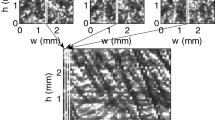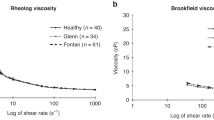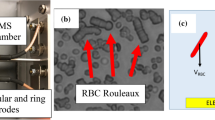Abstract
OBJECTIVE: Enhanced red blood cell (RBC) aggregation has an adverse effect on microcirculatory blood flow and tissue oxygenation. It has been previously shown that obesity is associated with increased RBC aggregation. The objectives of the present study were to further characterize obesity-related RBC aggregation and to examine whether the enhanced aggregation is a plasma- or cellular-dependent process.
METHODS: Obese (body mass index (BMI)=40±6.3 kg/m2, n=22) and nonobese (BMI=24±3.4 kg/m2, n=18) individuals were evaluated for inflammation markers and aggregation parameters. Aggregation parameters were derived from the distribution of RBC population into aggregate sizes, and from the variation of the distribution as a function of flow-derived shear stress, using a cell flow properties analyzer. To differentiate plasmatic from cellular factors, we determined the aggregation in the presence of autologous plasma or dextran-500kDa and calculated the plasma factor (PF) in the obese group. PF ranges from 0 to 1. When the PF=1, the aggregation is all due to plasmatic factors, when PF=0, the altered aggregation depends entirely on cellular factors, whereas 0<PF<1 reflects the joint contribution of cellular and plasmatic factors.
RESULTS: Obese subjects had relatively larger aggregates that were more resistant to dispersion by flow. The calculated PF in the obese group was 0.9, indicating a pronounced contribution of plasma to RBC aggregation in obesity.
DISCUSSION: Our results suggest that obese individuals present pathological plasma-dependent RBC aggregation, which is probably triggered by plasma macromolecules associated with the inflammatory response. These findings impact the future attempts to develop strategies aimed at attenuation of the enhanced RBC aggregation in obese individuals.
This is a preview of subscription content, access via your institution
Access options
Subscribe to this journal
Receive 12 print issues and online access
$259.00 per year
only $21.58 per issue
Buy this article
- Purchase on Springer Link
- Instant access to full article PDF
Prices may be subject to local taxes which are calculated during checkout

Similar content being viewed by others
References
Tateishi N, Suzuki Y, Cicha I, Maeda N . O2 release from erythrocytes flowing in a narrow O2-permeable tube: effects of erythrocyte aggregation. Am J Physiol Heart Circ Physiol 2001; 281: H448–H456.
Soutani M, Suzuki Y, Tateishi N, Maeda N . Quantitative evaluation of flow dynamics of erythrocytes in microvessels: influence of erythrocyte aggregation. Am J Physiol 1995; 268: H1959–H1965.
Pfafferott C, Moessmer G, Ehrly AM, Bauersachs RM . Involvement of erythrocyte aggregation and erythrocyte resistance to flow in acute coronary syndromes. Clin Hemorheol Microcirc 1999; 21: 35–43.
Samocha-Bonet D, Lichtenberg D, Tomer A, Deutsch V, Mardi T, Goldin Y, Abu-Abeid S, Shenkerman G, Patshornik H, Shapira I, Berliner S . Enhanced erythrocyte adhesiveness/aggregation in obesity corresponds to low-grade inflammation. Obes Res 2003; 11: 403–407.
Chien S . Rheology in the microcirculation in normal and low flow states. Adv Shock Res 1982; 8: 71–80.
Dintenfass L . Development of the blood viscosity factors. In: Dintenfass L, Boston MTP (eds) Blood Viscosity 1985. pp 45–112.
Nash GB, Wenby R, Sowemimo-Coker SO, Meiselman HJ . Influence of cellular properties on red cell aggregation. Clin Hemorheol 1987; 7: 93–108.
Snabre P, Bitbol M, Mills P . Cell disaggregation behavior in shear flow. Biophys J 1987; 51: 795–807.
Chen S, Barshtein G, Gavish B, Mahler Y, Yedgar S . Monitoring of red blood cell aggregability in a flow-chamber by computerized image analysis. Clin Hemorheol 1994; 14: 497–508.
Chen S, Gavish B, Zhang S, Mahler Y, Yedgar S . Monitoring of erythrocyte aggregate morphology under flow by computerized image analysis. Biorheology 1995; 32: 487–496.
Ben-Ami R, Sheinman G, Yedgar S, Eldor A, Roth A, Berliner AS, Barshtein G . Thrombolytic therapy reduces red blood cell aggregation in plasma without affecting intrinsic aggregability. Thromb Res 2002; 105: 487–492.
Ben-Ami R, Barshtein G, Zeltser D, Goldberg Y, Shapira I, Roth A, Keren G, Miller H, Prochorov V, Eldor A, Berliner S, Yedgar S, Sheinman G, Yedgar S . Parameters of red blood cell aggregation as correlates of the inflammatory state. Am J Physiol Heart Circ Physiol 2001; 280: H1982–H1988.
International committee for standardization in hematology. Recommendation of measurement of erythrocyte sedimentation rate of human blood. Immunochemistry 1965; 2: 235–254.
Clauss A . Gerinnungsphysiologische Shnellmethode zur Bestimmung des Fibrinogens. Acta Haematol Basel 1957; 17: 237–246.
Rifai N, Tracy RP, Ridker PM . Clinical efficacy of an automated high-sensitivity C-reactive protein assay. Clin Chem 1999; 45: 2136–2141.
Chen S, Eldor A, Barshtein G, Zhang S, Goldfarb A, Rachmilewitz E, Yedgar S . Enhanced aggregability of red blood cells of beta-thalassemia major patients. Am J Physiol 1996; 270: H1951–H1956.
Lemieux I, Pascot A, Prud'homme D, Almeras N, Bogaty P, Nadeau A, Bergeron J, Despres JP . Elevated C-reactive protein—another component of the atherothrombotic profile of abdominal obesity. Artheriosc Thromb Vasc Biol 2001; 21: 961–967.
Ford ES . Body mass index, diabetes and C-reactive protein among US adults. Diabetes Care 1999; 22: 1971–1977.
Baskurt OK, Yalcin O, Ozdem S, Armstrong JK, Meiselman HJ . Modulation of endothelial nitric oxide synthase expression by red blood cell aggregation. Am J Physiol Heart Circ Physiol 2004; 286: H222–H229.
Weng X, Roederer GO, Beaulieu R, Cloutier G . Contribution of acute-phase proteins and cardiovascular risk factors to erythrocyte aggregation in normolipidemic and hyperlipidemic individuals. Thromb Haemost 1998; 80: 903–908.
Vaya A, Martinez M, Carmena R, Aznar J . Red blood cell aggregation and primary hyperlipoproteinemia. Thromb Res 1993; 72: 119–126.
Caimi G, Lo Presti R, Montana M, Serra A, Grifo G, Canino B, Catania A, Sarno A . Diabetes mellitus: mean erythrocyte aggregation, glycometabolic pattern, red cell Ca2+ content, and erythrocyte membrane dynamic properties. Microvasc Res 1993; 46: 401–405.
Ravazian SM, Del Pino M, Simon A, Levenson J . Increase in erythrocyte disaggregation shear stress in hypertension. Hypertension 1992; 20: 247–252.
Kopelman PG . Obesity as a medical problem. Nature 2000; 404: 635–643.
El Bouhmadi A, Laffargue F, Raspal N, Brun JF . 100 mg acetylsalicylic acid acutely decreases red cell aggregation in women taking oral contraceptives. Clin Hemorheol Microcirc 2000; 22: 99–106.
Bilto YY . Rheological action of aspirin on human erythrocytes. Clin Hemorheol Microcirc 1999; 20: 159–165.
Berliner S, Rogowski O, Aharonov S, Mardi T, Tolshinsky T, Rozenblat M, Justo D, Deutsch V, Serov J, Shapira I, Zeltzer D . Erythrocyte adhesiveness/aggregation. A novel biomarker for the detection of low grade internal inflammation in individuals with atherothrombotic risk factors and proven vascular disease. Am Heart J, accepted for publication.
Valensi P, Paries J, Maheo P, Gaudey F, Attali JR . Erythrocyte rheological changes in obese patients: influence of hyperinsulinism. Int J Obes Relat Metab Disord 1996; 20: 814–819.
Caimi G, Lo Presti R, Serra A, Catania A, D'Asaro S, Verga S, Buscemi S, Sarno A . Rheological determinants and red cell lipidic pattern in essential obesity, in obese subjects with non-insulin dependent diabetes mellitus and in obese subjects with impaired glucose tolerance. Microcirc Endothelium Lymphatics 1991; 7: 293–304.
Mertens I, Van Gaal LF . Obesity, haemostasis and the fibrinolytic system. Obes Rev 2002; 3: 85–101.
Rampling MW, Whittingstall P, Linderkamp O . The effects of fibrinogen and its plasmin degradation products on the rheology of erythrocyte suspensions. Clin Hemorheol 1984; 4: 533–543.
Fabry TL . Mechanism of erythrocyte aggregation and sedimentation. Blood 1987; 70: 1572–1576.
Schechner V, Shapira I, Berliner S, Comaneshter D, Hershcovici T, Orlin J, Zeltser D, Rozenblat M, Lachmi K, Hirsch M, Beigel Y . Significant dominance of fibrinogen over immunoglobulins, C-reactive protein, cholesterol and triglycerides in maintaining increased red blood cell adhesiveness/aggregation in the peripheral venous blood: a model in hypercholesterolaemic patients. Eur J Clin Invest 2003; 33: 955–961.
Ben Assayag E, Bornstein N, Shapira I, Mardi T, Goldin Y, Tolshinski T, Vered Y, Zakuth V, Burke M, Berliner S, Samocha-Bonet D . Inflammation sensitive proteins and erythrocyte aggregation in atherothrombosis. Int J Cardiol, in press.
Ben-Ami R, Barshtein G, Mardi T, Deutch V, Elkayam O, Yedgar S, Berliner S . A synergistic effect of albumin and fibrinogen on immunoglobulin-induced red blood cell aggregation. Am J Physiol Heart Circ Physiol 2003; 285: H2663–H2669.
Lominadze D, Dean WL . Involvement of fibrinogen specific binding in erythrocyte aggregation. FEBS lett 2002; 517: 41–44.
Weng X, Cloutier G, Beaulieu R, Roederer GO . Influence of acute-phase proteins on erythrocyte aggregation. Am J Physiol 1996; 271: H2346–H2352.
Acknowledgements
Financial support of this work by the Szold Foundation (Hebrew University), the US-Israel Binational Science Foundation, No. 2001203 (to S Yedgar and G Barshtein), the Israel Science Foundation No. 558/03 (to S Yedgar and G Barshtein), the Walter and Greta Stiel Chair for Heart Studies (to S Yedgar), and the Buchmann Joseph Foundation (to D Samocha-Bonet) is acknowledged. We thank Mrs S Levy and Mrs O Fredman for technical assistance. This work was performed in partial fulfillment of the requirements for a PhD degree of Dorit Samocha-Bonet, Sackler faculty of medicine, Tel-Aviv University, Israel.
Author information
Authors and Affiliations
Corresponding author
Rights and permissions
About this article
Cite this article
Samocha-Bonet, D., Ben-Ami, R., Shapira, I. et al. Flow-resistant red blood cell aggregation in morbid obesity. Int J Obes 28, 1528–1534 (2004). https://doi.org/10.1038/sj.ijo.0802791
Received:
Revised:
Accepted:
Published:
Issue Date:
DOI: https://doi.org/10.1038/sj.ijo.0802791
Keywords
This article is cited by
-
Revisiting dextran effect on red blood cell to understand the importance of rouleaux distribution and red blood cell-endothelial cell adhesion
Biomass Conversion and Biorefinery (2022)
-
β-Dispersion of blood during sedimentation
Scientific Reports (2021)
-
Impact of sleeve gastrectomy on red blood cell aggregation: a 12-month follow-up study
International Journal of Obesity (2014)
-
The effects of weight loss due to gastric banding and lifestyle modification on red blood cell aggregation and deformability in severe obese subjects
International Journal of Obesity (2012)
-
Increased erythrocyte aggregation in men with coronary artery disease and erectile dysfunction
International Journal of Impotence Research (2009)



